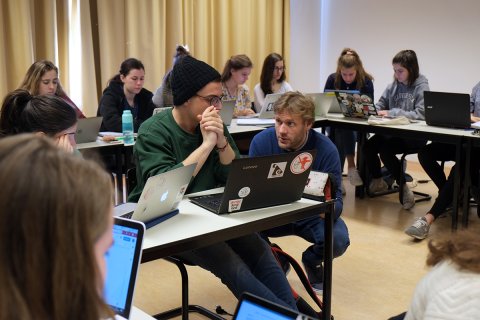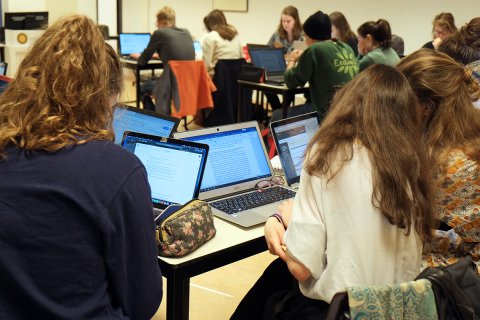Earth and Environment: a class where also Humanities majors feel at home
“This Summer term, I will take my students to the forest to measure carbon storage in trees,” tells Hugo de Boer, who started as Fellow in Environmental Sciences at University College Utrecht in November 2018. For him, science at its best comes close to puzzle solving.

University College Utrecht was not fully unknown to Hugo de Boer, who combines his new position with teaching and research at the Copernicus Institute of Sustainable Development at Utrecht University. It is in Utrecht where he has made most of his career, next to a postdoc in Australia. He had been teaching summer lab courses at University College Utrecht earlier as well, and when his colleague Maarten Eppinga, the former Environmental Science Fellow, found a new university position in Zurich last year, Hugo decided to go for the vacancy.
Intrinsic interest
“What was clear to me from my earlier courses at University College, was that students here are extremely motivated. They have an intrinsic interest in the subjects they are studying, and are prepared to work hard. I also see that their international and diverse background contributes positively to the class.”
In his first semester at the College, Hugo teaches the first-year course Introduction to Earth and Environment, which is open to all students. As the University College Utrecht first-year students have to take courses from all three departments, Humanities, Social Sciences and Science, the Earth and Environment class too accommodates students with very diverse interests.
“But the course is fit for that,” says Hugo. “Even a student with plans for majors in Humanities, for whom this course might be the one and only Science course, can cope with it, as it involves less calculation and statistics than many other Science courses. Besides, environmental issues hold a broad interest in society, and also among students.”

No wonder the course is very popular. All three Introduction courses offered annually are fully booked – in University College Utrecht terms, that means 28 students per class at maximum. On a Monday morning, the students are working on their laptops with full concentration, while Hugo is preparing a presentation of their collected course assignments on his own screen.
“They have each made a slide presenting one of the major biomes of the world. This week, the students represent the plant and animal communities specific to their chosen biome. Next week, the students study the specific environmental problems relevant to each biome, with the aim to learn more about the scope of this field of study.” One slide shows a structured analysis of a topic, while another is a cartoon-like photo collage, complete with speech bubbles. The diversity in the student shows.
The not-yet known
“I like solving puzzles,” tells Hugo about his own choice for science. “Careful data analysis is very much that. In my field of specialization, it means figuring out the level up to which CO2 can be assimilated by plants, for example.”
“When the CO2 level in the atmosphere rises, plants react by more photosynthetic activity, which leads to their larger assimilation capacity,” he explains about the topic of his former NWO VENI research.
“At this moment, about one third of the anthropogenic CO2 emissions are being assimilated by the land surface. If the CO2 level rises far higher, a saturation point will likely be reached, above which nature cannot take up its neutralizing task anymore. How the interaction between the CO2 level and nature works exactly, and what can be predicted, has not been researched sufficiently yet. It is exactly there that my interest lies, in that not-yet known area.’
For my students, I am always hoping that they allow themselves enough time to find out their real interest
Back in time, Hugo once was a Physics student, dreaming of a career in meteorology. Half-way his first year, he realized that the strong emphasis on mathematics was not for him, and he re-oriented himself towards Environmental Sciences.
“For my students, I am always hoping that they allow themselves enough time to find out their real interest. It is not a failure of character if you discover that you are not in the right place, on the contrary. I would like to encourage students to make their choice consciously, and according to their real interest, instead of carrying on with something simply because they have once started with it.”
Measuring trees
Soon, in June, the Earth and Environment summer course students will have the opportunity to try out problem solving on the spot. The two-week 'Carbon Storage in European Deciduous Forests' course largely consists of fieldwork and field visits. At the nearby country estate Oostbroek, they will learn how to test their own research hypothesis on forest carbon dynamics by measuring trees.
“The fieldwork teaches students how to analyze self-collected data. It is a very tangible exercise that is likely to make students understand what the textbook topics actually are about.” A piece of their own puzzle? “Oh yes.”

